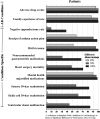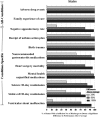Recognizing Differences in Hospital Quality Performance for Pediatric Inpatient Care
- PMID: 26169435
- PMCID: PMC4516938
- DOI: 10.1542/peds.2014-3131
Recognizing Differences in Hospital Quality Performance for Pediatric Inpatient Care
Abstract
Background: Hospital quality-of-care measures are publicly reported to inform consumer choice and stimulate quality improvement. The number of hospitals and states with enough pediatric hospital discharges to detect worse-than-average inpatient care remains unknown.
Methods: This study was a retrospective analysis of hospital discharges for children aged 0 to 17 years from 3974 hospitals in 44 states in the 2009 Kids' Inpatient Database. For 11 measures of all-condition or condition-specific quality, we assessed the number of hospitals and states that met a "power standard" of 80% power for a 5% level significance test to detect when care is 20% worse than average over a 3-year period. For this assessment, we approximated volume as 3 times actual 2009 admission volumes.
Results: For all-condition quality, 1380 hospitals (87% of all pediatric discharges) and all states met the power standard for the family experience-of-care measure; 1958 hospitals (95% of discharges) and all states met the standard for adverse drug events. For condition-specific quality measures of asthma, birth, and mental health, 203 to 482 hospitals (52%-90% of condition-specific discharges) met the power standard and 40 to 44 states met the standard. One hospital and 16 states met the standard for sickle cell disease. No hospital and ≤27 states met the standard for the remaining measures studied (appendectomy, cerebrospinal fluid shunt surgery, gastroenteritis, heart surgery, and seizure).
Conclusions: Most children are admitted to hospitals in which all-condition measures of quality have adequate power to show modest differences in performance from average, but most condition-specific measures do not. Policies regarding incentives for pediatric inpatient quality should take these findings into account.
Copyright © 2015 by the American Academy of Pediatrics.
Figures


Similar articles
-
Hospital care for children with hydrocephalus in the United States: utilization, charges, comorbidities, and deaths.J Neurosurg Pediatr. 2008 Feb;1(2):131-7. doi: 10.3171/PED/2008/1/2/131. J Neurosurg Pediatr. 2008. PMID: 18352782
-
Hospital volumes for common pediatric specialty operations.Arch Pediatr Adolesc Med. 2007 Jan;161(1):38-43. doi: 10.1001/archpedi.161.1.38. Arch Pediatr Adolesc Med. 2007. PMID: 17199065
-
Pediatric Hospital Discharges to Home Health and Postacute Facility Care: A National Study.JAMA Pediatr. 2016 Apr;170(4):326-33. doi: 10.1001/jamapediatrics.2015.4836. JAMA Pediatr. 2016. PMID: 26902773
-
Quality improvement research in pediatric hospital medicine and the role of the Pediatric Research in Inpatient Settings (PRIS) network.Acad Pediatr. 2013 Nov-Dec;13(6 Suppl):S54-60. doi: 10.1016/j.acap.2013.04.006. Acad Pediatr. 2013. PMID: 24268086 Review.
-
Quality and Safety of Pediatric Inpatient Care in Community Hospitals: A Scoping Review.J Hosp Med. 2019 Nov 1;14(11):694-703. doi: 10.12788/jhm.3268. Epub 2019 Sep 18. J Hosp Med. 2019. PMID: 31532739 Free PMC article.
Cited by
-
Epidemiology of pediatric hospitalizations at general hospitals and freestanding children's hospitals in the United States.J Hosp Med. 2016 Nov;11(11):743-749. doi: 10.1002/jhm.2624. Epub 2016 Jul 4. J Hosp Med. 2016. PMID: 27373782 Free PMC article.
-
Are Pediatric Readmission Reduction Efforts Falling Flat?J Hosp Med. 2019 Oct;14(10):644-645. doi: 10.12788/jhm.3269. J Hosp Med. 2019. PMID: 31577224 Free PMC article. No abstract available.
-
How Does Pediatric Quality Measure Development Reflect the Real World Needs of Hospitalized Children?Acad Pediatr. 2022 Apr;22(3S):S70-S72. doi: 10.1016/j.acap.2021.01.019. Acad Pediatr. 2022. PMID: 35339245 Free PMC article. No abstract available.
-
Categorizing Hospitals by Neonatal and Pediatric Diagnoses Treated.Pediatrics. 2025 Feb 1;155(2):e2024067859. doi: 10.1542/peds.2024-067859. Pediatrics. 2025. PMID: 39778595
-
Pediatric Price Transparency: Still Opaque With Opportunities for Improvement.Hosp Pediatr. 2017 Oct;7(10):565-571. doi: 10.1542/hpeds.2017-0020. Epub 2017 Sep 5. Hosp Pediatr. 2017. PMID: 28874404 Free PMC article.
References
-
- Epstein AM. Public release of performance data: a progress report from the front. JAMA. 2000;283(14):1884–1886 - PubMed
-
- Chassin MR, Hannan EL, DeBuono BA. Benefits and hazards of reporting medical outcomes publicly. N Engl J Med. 1996;334(6):394–398 - PubMed
-
- Centers for Medicare & Medicaid Services. Hospital compare. Available at: www.hospitalcompare.hhs.gov/. Accessed March 19, 2015
-
- Hannan EL, Kilburn H, Jr, Racz M, Shields E, Chassin MR. Improving the outcomes of coronary artery bypass surgery in New York State. JAMA. 1994;271(10):761–766 - PubMed
-
- Jha AK, Epstein AM. The predictive accuracy of the New York State coronary artery bypass surgery report-card system. Health Aff (Millwood). 2006;25(3):844–855 - PubMed
Publication types
MeSH terms
Grants and funding
LinkOut - more resources
Full Text Sources
Other Literature Sources
Medical
Miscellaneous

